
Number 7 recently swam in her first swim meet.
At four years old, she swims all four strokes legally, which, at that age, is pretty unusual. And so we officially have 5 kids ranging in age from 4 to 11 on the swim team.
I’ve been coaching swimming in some capacity since I was a junior in high school. I’ve coached country club teams, high school teams, USS teams, Y teams and Special Olympic teams.
I’ve coached every level of swimming from the preschool all the way through high school.
I’ve given swim lessons to people of every age from toddlers to adults.
So people assume that my kids are strong swimmers because I have taught them all how to swim.
They probably assume that I’ve forced my kids to join the swim team, too. (Or that I’ve at least strongly pushed them in that direction).
But that’s not the case. It really isn’t.
I have spent much much much more time directly instructing other peoples’ children in the pool than I have my own.
And my kids have never had lessons with anyone else.
But there is a reason my kids are strong swimmers. A few reasons, actually.
And I want to share them with you because swimming is one of those skills that isn’t really optional.
Your kids need to learn how to swim. They don’t need to be able to swim all four strokes legally. They don’t really need to swim any particular stroke.
But your kids need to be safe in the water.
So how do you make that happen? And how can you do that without shelling out thousands of dollars for swim lessons?
Well, there are some things you can do starting from an early age that will make a big difference.
1 ) DO NOT keep your kid’s face dry at all costs.
One of the biggest reasons kids have trouble learning to swim is because they don’t like to get their faces wet. This causes your kid to keep his face and head out of the water as high as possible. The higher your head is out of the water, the lower your legs and butt are in the water. It makes your body go from being horizontal to vertical.
It is very difficult to swim when you are vertical.
When my kids were little — I’m talking like one, two, and three months old — when I gave them baths in those little plastic tubs, I made sure I got some water on their faces. Not massive amounts. But I would sprinkle water on their faces to get them used to being splashed by water.
When they got older and had a bath in the regular tub, I made sure to pour water on top of their heads so it would run down their faces.
Again, I didn’t do it in a mean or scary way, but I did it to get them used to the feeling of water on their faces.
2) Teach your kid to hum in the water.
A lot of swim lesson instructors will tell your kid to “blow bubbles.”
Blowing bubbles is great for encouraging kids to put their mouths in the water. But when you are blowing bubbles, you can still get water up your nose, which is another thing that holds kids back from becoming comfortable in the water.
When you hum when your face is in the water, it’s impossible to get water in your mouth or up your nose.
I taught my kids to hum with their faces in the water in the bath tub.
If you want to try this at home, for some kids it takes a lot longer than others. Encourage your children to start humming before they put their face in the water and to keep humming until they take their face all the way out.
3 ) Spend as much time in the water as possible.
I know this can be difficult if you don’t have a pool or you don’t belong to a place that has a pool. But this is one of the biggest reasons my kids are good swimmers. My kids spend a tremendous amount of time in the water. Having a pool at our house helps.
But Number 1 and Number 2 learned how to swim fairly young and there was no pool around for them when they were little. At least once every weekend my husband took the boys swimming at the Y for free swim for at least an hour. They spent quite a bit of time in the water. And that’s really how they learned to swim. Just by repetition and spending time in the water.
Just as with anything else, the more time you spend doing something, the better you get at it, and the more comfortable you are with it.
If you can afford to join a place that has a pool, DO IT. And then go there as often as you can. (It’s a great way to wear your kids out when they are driving you crazy, and it’s good for them, too!)
4) Invest in a puddle jumper (affiliate).
Once the kids turned two years old, I put them in a puddle jumper for the summer. If they were outside by the pool, they knew they needed to put their swimmie on. It just became an automatic habit.
My kids wore those things all summer long, whether they were in or out of the pool.
Whether they were near a big pool or a small one.
Wherever they were, they had them on.
It was just a “given” and they automatically put them on. They were a part of the regular getting-ready-to-go-outside routine.

The kids weren’t bothered by them at all, and they didn’t prevent them from doing stuff outside the water either.

I like these puddle jumpers much better than a life jacket because they encourage your body to go into a more natural swimming position, and they help your children learn how to kick fairly quickly. Life jackets also don’t stay in place very well, and as soon as your kids are in the water, they are pushing up against your kid’s chin and making moving around very awkward and much more difficult.
Not only did the puddle jumpers help them to learn to swim and enable them to have a little freedom in the pool before they could swim independently, but they also gave me some peace of mind while they were playing near the pool.

If they were anywhere near the pool, they had them on.
OF COURSE THIS DOESN’T MEAN YOU CAN THROW ONE OF THESE ON AND LEAVE YOUR CHILD UNATTENDED BY A POOL!!!
You always need to monitor your kids closely when they are near or in the pool. But this gives you some peace of mind and gives them some protection should they somehow manage to get into the pool without you realizing it.
5) Invest in a good pair of goggles (affiliate).
Another reason your kid may be reluctant to put his or her face in the water (which makes learning to swim much more difficult) is because getting water in their eyes really bothers them.
A lot of parents get really cheap goggles at a place like the Dollar Store. Or you get those “really cool” ones that your kids see that have lobsters on them or sharks or Disney princess stuff on them.
They may be cute or really inexpensive, but chances are they also won’t work at all.
And they’ll break within a week.
The best goggles out there are the Speedo Jr. Vanquisher (affiliate) goggles. They are made for kids, they are easily adjustable, and they are durable. They come in a whole bunch of colors, and you can get mirrored ones which really work well in the summer. Yeah, they cost more than Dollar Store goggles, but you’ll only have to buy one pair for the summer (as long as you don’t lose them). They are the only goggles my kids wear.

A good pair of goggles that doesn’t leak will help your child (along with the humming) to feel much more comfortable putting her face in the water.
Once he or she is comfortable putting his or her face in the water, learning to swim will come pretty quickly.
When you get to that point, it’s just a matter of spending as much time in the water as you can. Not making your kids swim laps — having fun.
Playing. Diving for diving sticks. Doing anything that increases their stamina in the water.
It’s the same as teaching your kid to read in kindergarten.
You can teach your child to read. That’s not for everyone though.
I know I wanted to leave that up to the kindergarten teacher. But I wanted my kids to be ready to learn.
Reading starts with exposing them to as many books as you can. If you send your child to school knowing the letters of the alphabet, his teacher will be able to teach him to read much more quickly than if she has to start with the very basics of letter recognition.
If you aren’t looking to teach your child how to swim on your own, you can do a lot of the prep work when it comes to swimming, too. Rather than spending thousands of dollars and dozens and dozens of weeks putting your child in swim lessons and having it take an entire session for your child to even dip her chin in the water, lay the groundwork yourself.
When you send your child to swim lessons feeling comfortable in the water and able to put his face in the water easily without having a complete and total freak out, you will progress much more quickly.
And then you’ll have a child who is safe, strong, and independent in the water.

I’m a mom with three swim team kids. Great advice!
Great post! Water safety is so important and it opens up a lot of fun activities. My 5 year old is begging to surf now that he has “mastered” the pool.
great post! wish i’d read it a few years ago…
Thanks for your information.
I really want my kids to swim.
Me myself don’t know to swim.
So any different advice for us adults that don’t know how to swim?
Great tips. All my children and grandchildren started swimming by the time they were 2